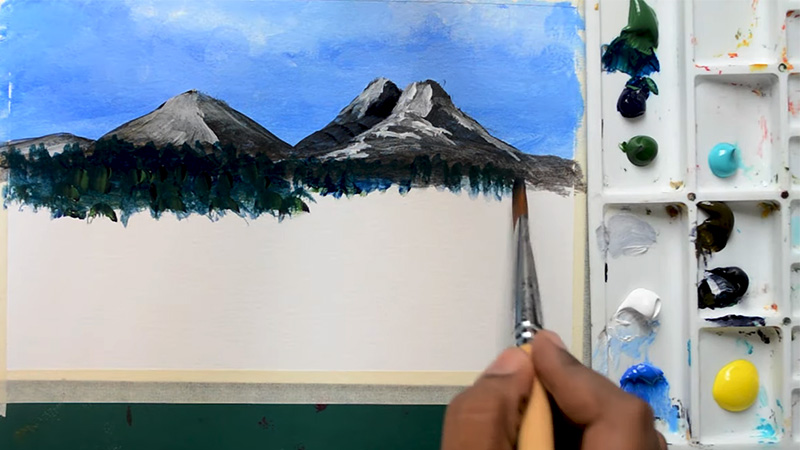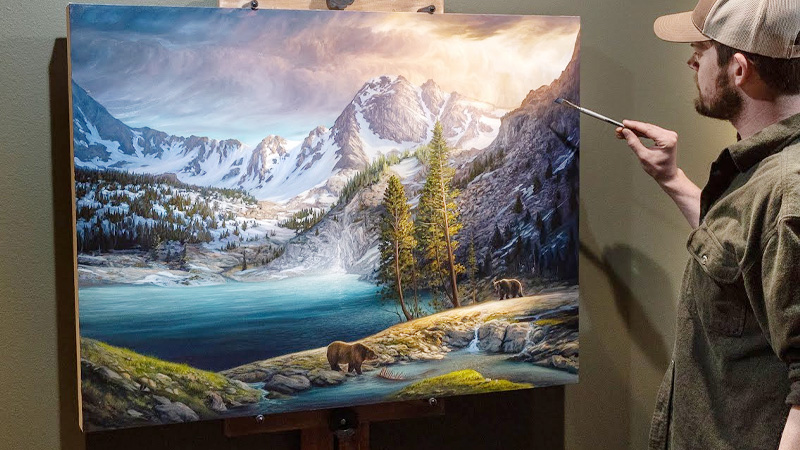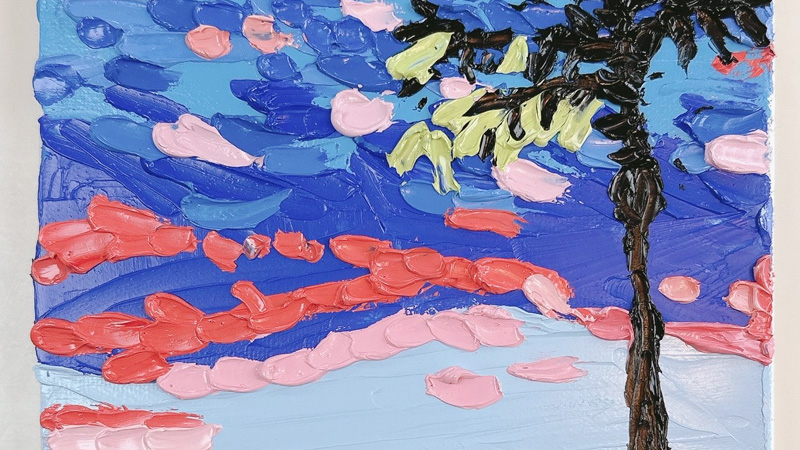Using oil paints on paper is a captivating artistic technique that allows you to unleash your creativity with vibrant colors and rich textures. While canvas is the traditional surface for oil painting, paper offers its own unique charm and challenges.
In this guide, we will explore the step-by-step process of using oil paints on paper, from selecting the right materials and preparing your workspace to mastering various techniques and achieving stunning results.
Whether you’re an experienced artist or a beginner eager to experiment with oils, this introduction sets the stage for a rewarding journey into the world of oil painting on paper, where you can craft expressive, captivating artworks that showcase your artistic vision.

How to Use Oil Paints on Paper?
Using oil paints on paper can be a captivating and versatile artistic pursuit. While oil painting is traditionally associated with canvas, employing this medium on paper allows artists to explore unique textures, effects, and creative possibilities.
Here’s a comprehensive guide on how to use oil paints on paper:
Gather Your Materials
To embark on your oil painting journey on paper, gather the essential materials. Acquire high-quality oil paints with a diverse color range, heavyweight paper specifically designed for oil painting (preferably with a weight of 140lb or higher to prevent warping),
suitable brushes for oil painting (natural bristle or synthetic), a palette for mixing paints, various oil mediums such as linseed oil or stand oil, palette knives for paint mixing, an easel to provide support, and rags or paper towels for brush cleaning and correcting mistakes.
Prepare Your Workspace
Before diving into your painting, arrange your workspace thoughtfully. Set up your easel and organize your materials within easy reach. Ensure you have good lighting and proper ventilation to create a comfortable and conducive environment for your creative process.
Prepare Your Paper
Prior to applying any paint, prepare your paper surface. If the paper has a smooth or glossy finish, gently sand it or use rubbing alcohol to remove any coatings.
This step is crucial for promoting paint adhesion and ensuring your oil paints adhere well to the paper.
Prime the Paper
To protect your paper and provide a suitable surface for oil paint, apply a layer of gesso or an oil painting medium. This layer prevents the oil from seeping into the paper, preserving its integrity.
Allow the primer to dry completely before moving on to the next step.
Select Your Colors
Begin your creative journey by selecting a limited color palette. A focused selection simplifies color mixing and allows you to concentrate on mastering the chosen hues, creating harmonious and coherent artwork.
Mix Your Paints
Squeeze out your chosen oil paint colors onto your palette and begin mixing them to achieve the precise shades you desire. One of the advantages of oil paints is their slow drying time, which provides ample opportunity to work with your colors without feeling rushed.
Apply Thin Layers
Initiate your painting with a thin underpainting, applying paint sparingly to the paper’s surface. Gradually build up layers as necessary, ensuring each layer dries completely before adding the next.
This gradual approach prevents oversaturation of the paper.
Experiment With Techniques
Explore a variety of oil painting techniques such as glazing for transparent layers, impasto for thick and textured application, scumbling for softening edges, and blending to create smooth transitions.
Bear in mind that paper is more delicate than canvas, so handle it gently to avoid damage.
Allow for Drying Time
Patience is key when working with oil paints on paper. These paints can take days to weeks to dry thoroughly, depending on factors like layer thickness and environmental conditions.
Be patient to avoid smudging or disrupting your artwork.
Clean Your Brushes
Maintain the quality of your brushes by cleaning them after each painting session. Use an appropriate oil paint solvent or mineral spirits to remove any remaining paint and residue from your brushes.
Protect Your Artwork
Once your oil painting on paper is fully dry, consider framing it under glass to safeguard it from dust and damage. Ensure your artwork is completely dry before framing to prevent any moisture-related issues.
How Long Does Oil Paint Paper Take to Dry?

Oil paint on paper typically takes a considerable amount of time to dry, often longer than on other surfaces like canvas. The drying time can vary based on factors such as the thickness of the paint layers, humidity levels, and the type of oil paint used.
In general, thin layers of oil paint on paper may take several days to a few weeks to dry completely. Thick impasto layers can take even longer, potentially several months.
To avoid smudging or damaging the artwork, it’s essential to exercise patience and allow ample time for the oil paint to dry thoroughly before framing or varnishing.
What Kind of Paper Is Used for Oil Painting?
Selecting the right paper for oil painting is crucial to ensure the quality and longevity of your artwork. While canvas is the traditional surface for oil paints, several types of paper can be used effectively with the proper preparation.
Here are some paper options suitable for oil painting:
Oil Painting Paper
Oil painting paper is specially designed for the unique demands of oil paints. It is heavyweight, typically ranging from 140lb (300gsm) and higher. This paper is pre-primed with a surface that can withstand the corrosive nature of oil paints.
You can recognize it by labels such as “oil paper” or “oil painting paper.” These papers provide a reliable and convenient choice for oil painting without the need for additional priming.
Watercolor Paper
While primarily intended for watercolors, heavyweight watercolor paper can also be used for oil painting when properly prepared. The watercolor paper should be at least 140lb (300gsm) or heavier.
It’s essential to prime the watercolor paper thoroughly with gesso or an oil painting medium to create a protective barrier between the paper fibers and the oil paint.
This step prevents the oil from seeping into the paper and causing deterioration over time.
Printmaking Paper
Certain printmaking papers, such as etching or intaglio papers, have the necessary weight and texture to handle oil paints effectively. These papers are often sturdy and may add unique textural qualities to your oil paintings.
As with watercolor paper, proper priming is essential to protect the paper and ensure the longevity of your artwork.
Bristol Board
Bristol board is a heavyweight, smooth-surfaced paper commonly used for various art mediums, including oil paints. It provides a smooth canvas for detailed and precise brushwork.
As with other paper options, it should be primed with gesso or an oil painting medium before applying oil paints.
Canvas Paper
Canvas paper is a lightweight paper with a texture designed to mimic traditional canvas fabric. While not as robust as actual canvas, it can still work for oil painting when adequately primed.
Canvas paper is an excellent choice if you want to experiment with a canvas-like texture on paper.
Wood Panels
Although not paper, wood panels offer another excellent surface for oil painting. They are rigid, durable, and can handle oil paints effectively. Wooden panels come in various sizes and thicknesses and are often preferred by artists who want a solid foundation for their artwork.
Essential Tips for Mastering Oil Painting on Paper

Exploring the world of oil painting on paper is a rewarding artistic venture. In this guide, we’ll share valuable tips to help you master this unique medium with confidence.
Here are some important tips for using oil paints on paper:
Choose the Right Paper
Select heavyweight paper specifically designed for oil painting. Papers with a weight of 140lb (300gsm) or higher are ideal to prevent warping and ensure the paper can handle the weight of oil paint and mediums. Consider the texture and surface finish of the paper to achieve the desired effects in your artwork.
Prime the Paper
Before applying oil paints, it’s essential to prime your paper surface. Use acrylic gesso or an oil-based primer to seal the paper. Priming prevents the oil from seeping into the paper fibers, which can lead to deterioration. Allow the primer to dry thoroughly before starting your artwork.
Use a Limited Color Palette
Begin with a limited selection of colors to simplify the mixing process and maintain color harmony in your artwork. A well-chosen palette can help you achieve more cohesive and visually appealing results.
Experiment with Mixing Mediums
Oil painting mediums like linseed oil or stand oil can be used to modify paint consistency, improve flow, and enhance drying time. Experiment with different mediums to achieve the desired texture and effects in your painting.
Apply Thin Layers and Gradual Build-Up
Start with thin underpainting layers and gradually build up thicker layers as needed. Allowing each layer to dry thoroughly before adding the next one helps prevent oversaturation of the paper and ensures better adhesion of subsequent layers.
Blend with Solvents
Use appropriate solvents like odorless mineral spirits or turpentine for blending and achieving smooth transitions between colors. Be mindful of using solvents sparingly to avoid over-saturation of the paper.
Apply Impasto Techniques Carefully
If you plan to use impasto techniques (thick paint application), be cautious, as paper is more delicate than canvas. Ensure your paper can handle the weight of thick paint without warping or tearing. You might consider using a thicker paper for impasto work.
Maintain a Clean Palette
Frequently clean your palette to prevent color contamination and ensure accurate color mixing. A clean palette helps you achieve the precise colors you intend to use.
Be Patient with Drying Times
Oil paints have a slow drying time, which can range from days to weeks depending on layer thickness and environmental conditions. Be patient and avoid touching or stacking your artwork until it’s fully dry to prevent smudging or damage.
Protect Finished Artworks
Once your oil painting on paper is dry, consider framing it under glass to protect it from dust, moisture, and physical damage. Ensure the artwork is fully dry before framing to prevent any issues with humidity.
Explore Different Paper Types
Don’t limit yourself to a single type of paper. Experiment with various paper types, including watercolor paper, printmaking paper, and specialty oil paper, to discover how each one influences your artwork’s texture and appearance.
Keep Records and Experiment
Maintain a sketchbook or journal to record your experiments, color mixes, and techniques. Don’t hesitate to try new methods and push the boundaries of your creativity with oil paints on paper.
FAQs
Can I use regular paper for oil painting?
No, it’s advisable to use heavyweight paper specifically designed for oil painting. Regular paper can’t handle the moisture and weight of oil paints.
Do I need to prime the paper before painting with oils?
Yes, it’s crucial to prime the paper with gesso or an oil painting medium. This protects the paper and ensures the longevity of your artwork.
Can I frame an oil painting on paper without glass?
It’s recommended to frame oil paintings on paper under glass to protect them from dust and damage.
What brushes should I use for oil painting on paper?
Use brushes suitable for oil paints, such as natural bristle or synthetic brushes designed for oil painting.
Can I use watercolor paper for oil painting?
Yes, you can use heavyweight watercolor paper, but be sure to prime it properly with gesso or an oil medium.
To Recap
The art of using oil paints on paper opens up a realm of creativity and expression that is both captivating and versatile. Throughout this guide, we have delved into the essential steps and considerations necessary to embark on this artistic journey.
From preparing your materials and priming the paper to mastering various techniques and patiently allowing your artwork to dry, oil painting on paper offers a unique experience that can yield stunning and enduring results.
As you continue to explore this medium, remember that practice, experimentation, and patience are your allies. With dedication and a willingness to embrace the possibilities that oil paints on paper provide, you can unlock your artistic potential and create captivating, memorable works of art that reflect your unique vision and style.
Leave a Reply